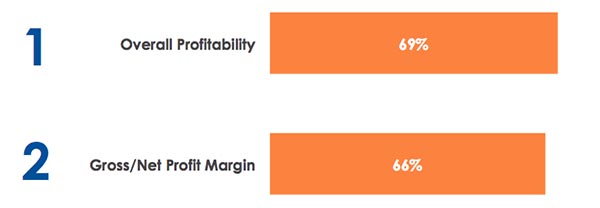- Print service providers are evaluating their customer bases, application mixes (with many having already added wide-format capabilities and now eyeing packaging), and business models.
- Today’s print service providers must continuously monitor the right financial and operational metrics to improve the health of their operations.
- According to Keypoint Intelligence – InfoTrends’ research, European print service providers are in general alignment about the financial metrics that are important to monitor. Overall profitability and gross/net profit were the two most important financial indicators to gauge business health.
By Ryan McAbee
Introduction
We’ve just started another new year and a new decade. For those of us in the printing industry, 2020 is shaping up to be a pivotal year. Print service providers (PSPs) continue to evaluate their customer bases, application mixes (with many having already added wide-format capabilities and now eyeing packaging), and business models. As we move through this new decade, there are several points of disruption that are expected to emerge. To remain competitive in the future, PSPs must prepare themselves for the following developments:
- Digital printing technologies are accelerating in speed, quality, and reliability, particularly for inkjet-based solutions.
- Smart Print Manufacturing (SPM) processes, such as mass customization, will be enhanced by the effective use of business intelligence/data analytics, edge computing, and increasingly robotics.
- Thanks to the Industrial Internet of Things (IIoT) and connected equipment, operational and business data is abundant. At the same time, however, this data is currently underutilized.
- The way customers are procuring print continues to move online and will be influenced by online design platforms and global print provider networks.
Today, more than ever, PSPs must continuously monitor the right financial and operational metrics to improve the health of their operations. They must also account for the future investments that will be necessary as the industry continues to shift.
The Use and Impact of Financial and Operational KPIs
To better support the industry, Keypoint Intelligence – InfoTrends is currently conducting research centered on the use and impact of financial and operational key performance indicators (KPIs) for North American and European PSPs. Scheduled to publish later this year, this research will provide valuable insights for PSPs on an international level. Some of the initial findings from Europe are currently under evaluation, and some interesting trends are already beginning to emerge. Specifically:
- European PSPs appear in general alignment about the financial metrics that are important to monitor. Nearly 70% of respondents indicated that overall profitability and gross/net profit were the two most important financial indicators to gauge the health of their businesses. More importantly, PSPs who had experienced revenue decline over the past five years were far less likely to measure and monitor either financial KPI.
Top Financial KPIs

N = 200 Respondents in Europe
Source: European Software Investment Survey, Keypoint Intelligence – InfoTrends 2020
- European PSPs were slightly less in agreement about the operational metrics that were most important to track. Only the need to track sellable, rejected, and waste work were important over half of respondents, while equipment uptime was the second most important operational KPI. Once again, InfoTrends’ research spotlighted a critical difference between those monitoring equipment uptime (and Overall Equipment Effectiveness) vs. those that did not—printers that experienced revenue declines were far less likely to use those KPIs.
Top Operational KPIs

N = 200 Respondents in Europe
Source: European Software Investment Survey, Keypoint Intelligence – InfoTrends 2020
To date, obtaining a holistic view of financial and operational KPIs has required the collection of shop floor data from operations and the use of multiple software solutions. Emerging software tools promise the ability to aggregate data from nearly any data source and present actionable information through customizable dashboards. As the need for data-driven print operations becomes the norm, the difficulty in implementing such solutions should decrease, perhaps through the adoption of a standardized method for data exchange.
The Bottom Line
The start of a new decade is a great time to take a reflective look at the financial and operational information that is used to strategically guide your business. Are some metrics being collected in a certain way out of habit but not providing any valuable insight? Are there better methods for collecting and evaluating business performance and efficiency that should be adopted? Are KPIs well-understood and being monitored by responsible personnel on a timely and routine basis? These are just a few of the questions that PSPs must ask themselves as they continue on their path to become data-driven.
To learn more about the use and impact of data sharing, access Keypoint Intelligence – InfoTrends’ Three Questions to Explore to Build a Data-Driven In-Plant in 2020 blog post.
Ryan McAbee is a Director for Keypoint Intelligence – InfoTrends' Production Workflow Consulting Service, which focuses on providing technology, business, and market insights to clients in the Digital Marketing & Media and Production Workflow markets. In this role, he is responsible for conducting market research, market analysis and forecasting, content development, industry training, and consulting with print service providers.










Discussion
Join the discussion Sign In or Become a Member, doing so is simple and free